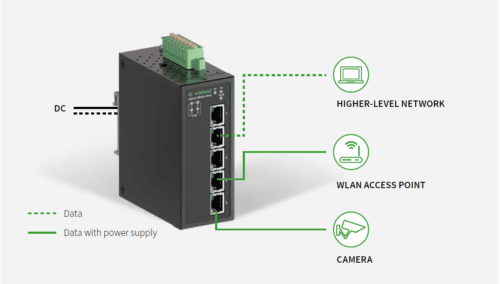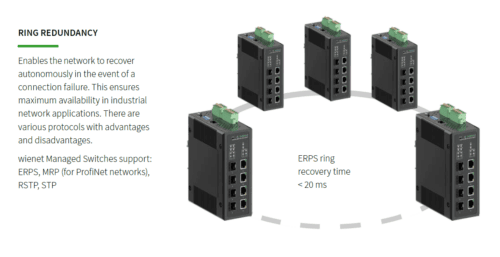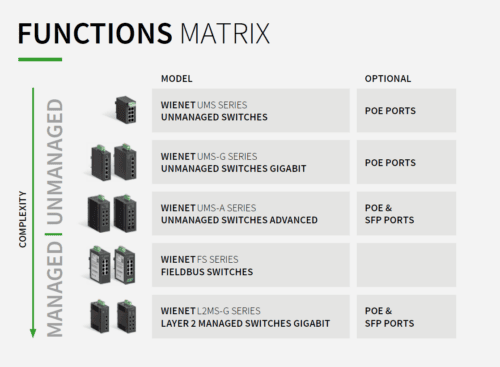How To Choose the Right Ethernet Switch
An Ethernet switch is a networking device used to connect multiple devices in a local area network (LAN). It is extensively used in home, office, and industrial environments to promote resource sharing and data transmission across connected devices. Its primary function is to receive incoming data packets from one gadget and forward them to the appropriate network destination device.
Ethernet switches typically have multiple ports, allowing numerous gadgets such as computers, servers, and printers to be connected simultaneously. Each port on the switch connects to a single device, allowing for efficient and concurrent communication between units. It’s worth noting that some switches with rugged structures can withstand extreme temperatures and harsh conditions, which are crucial in environments where the temperatures are challenging.

This article will explore the key factors to consider when choosing the right control for a specific industrial application.
Key Considerations for Ethernet Switches
With several options available, choosing an Ethernet switch is crucial for optimal network performance and scalability. Here are some of the most essential factors to take into account:
Switch Capacity
Switch capacity refers to the ability to handle and process network traffic efficiently. It is often gauged through the switching fabric and forwarding rate. The switching fabric represents the internal architecture and bandwidth of the switch. Meanwhile, the forwarding rate measures the number of packets it can process per second.
If the switch’s capacity is insufficient for the network’s demands, it can result in congestion, lost packets, increased latency, and degraded performance.
Port Configuration
Port configuration is the arrangement and settings of individual ports on an Ethernet switch. It involves determining the number and type of ports needed and configuring specific parameters to optimize network connectivity and functionality. It also often accesses the switch’s management interface through a command-line interface (CLI) or a graphical user interface (GUI).
For example, Small form-factor pluggable (SFP) ports are a type of network interface commonly used in networking equipment like switches and routers. These ports are designed to be compact and easy to replace. They allow the connection of different types of optical or copper transceivers, which transmit data over various network cables.
Ethernet switches also offer the following port types:
- Ethernet ports
- Fast Ethernet ports
- Gigabit Ethernet ports
- Power over Ethernet (PoE) ports
Wienet Technical Data at a glance
Network Infrastructure
Network infrastructure is the underlying framework and components that enable communication, connectivity, and data transfer within a computer network. It encompasses the physical and virtual elements required to establish, operate, and manage a network effectively. A well-designed and robust network infrastructure is crucial for reliable and efficient operations.
One critical network infrastructure component is the switches, which act as intelligent devices facilitating data flow between networked devices. There are two primary types of switches: managed switches and unmanaged switches. A managed switch offers a higher level of control and configurability. Network administrators can access a management interface such as a command-line interface (CLI) or a web-based graphical user interface (GUI) to configure various settings.
In contrast, an unmanaged switch is a plug-and-play device that requires no user configuration. It operates without any setup and is suitable for simple networks where basic connectivity is the primary requirement. These switches are cost-effective and straightforward, making them ideal for small home or office setups.
At Wieland Electric, we understand the importance of steady data communication within Ethernet networks. This is why we have developed our Wienet® product range. It offers a comprehensive solution for organizing data traffic within the Ethernet network. One of its key aspects is the ability to prioritize data packets. This means critical data can be prioritized, ensuring it reaches its destination promptly.
Here are some elements encompassing our Wienet® product range:
- Wienet® Managed Switches
- Managed Industrial Protocol Switches Wienet® FS Series
- Managed Gigabit Switches Wienet® L2MS-G Series
- Wienet® Unmanaged Industrial Ethernet Switches
- Unmanaged Fast Ethernet Switches Wienet®UMS Series
- Unmanaged Gigabit Ethernet Switches Wienet®UMS-G Series
- Unmanaged Fast Ethernet Switches Wienet®UMS-A Series
See all options in the industrial network switches catalog.
Speed and Bandwidth Requirements
Network speed refers to the rate at which data can be transmitted. It is measured in bits per second (bps), kilobits per second (Kbps), megabits per second (Mbps), or gigabits per second (Gbps). On the other hand, bandwidth represents the maximum capacity or throughput of a network connection. Meeting these requirements requires selecting switches that support the desired speeds.
Mountability and Connection Options
Certain Ethernet switches are intentionally versatile in their design, and some variations are even Din rail mountable. This means they can be firmly affixed to a standard Din rail within industrial environments. This feature ensures stability and ease of installation, making these switches suitable for use in diverse industrial settings.
Additionally, some switches support fiber optic connections. This enables high-speed data transmission, making them ideal for applications where rapid data transfer is crucial. Their ability to transmit data over long distances without signal degradation makes fiber optic connections essential for network setups requiring extended reach.
Enhance Your Electrical Connectivity With Wieland Electric’s Solutions!
At Wieland Electric, we take pride in our position as a leading electrical connection and industrial automation manufacturer! We deliver innovative solutions prioritizing electrical systems’ safety, reliability, and efficiency. Our product portfolio encompasses many solutions, from reliable connectors and cables to advanced automation components.
Contact us today for more information!


